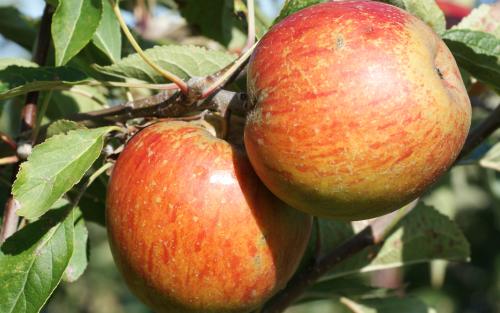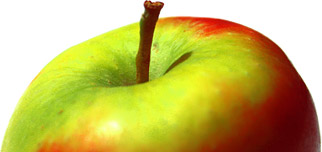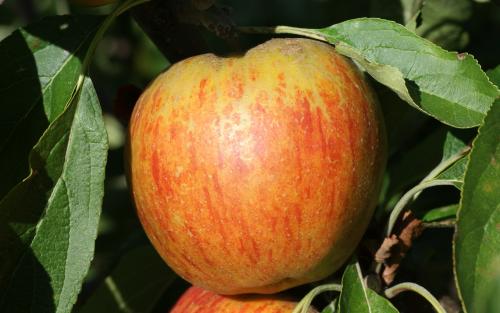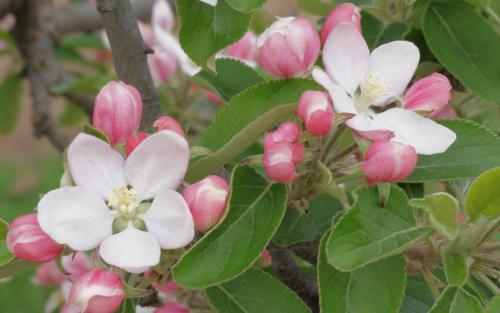
Margil is amongst the oldest of dessert apple varieties grown in England. Robert Hogg, writing in his book 'The Fruit Manual' in 1884 claims that Margil is:
"One of the finest dessert apples, a rival of the Ribston Pippin, excelling it in juiciness, and being of a better size for dessert."
Although its origins are unknown Hogg reports evidence of cultivation at Brompton Park Nursery in the 1750s. He also suggests that the variety is French in origin, partly from its name, and partly because one of the partners in the Brompton Park Nursery had previously worked in the gardens at Versailles. This makes Margil one of a select band of apple varieties with a documented history going back more than 250 years.
Margil is a fairly small apple, with an attractive flushed appearance, and a strong, clean, well-balanced flavour which puts it very much in the mainstream of Cox-style apples. Only the tendency to russetting might be held against it. Although separated by at least 200 years, Margil is quite similar in flavour to Braeburn, and has no trouble holding its own against modern varieties.
Margil is quite easy to grow, and is a particularly good choice if you have a mild temperate maritime climate. It is a popular variety in south-west Scotland and the English Lake District.
We speculated here, in a previous version of this page, that Margil was remarkably similar to Cox's Orange Pippin - the flattened shape, flushed russet tones, and tremendous depth of flavour all suggested that somewhere there must be a common ancestor. Since then genetic testing has confirmed that Margil is indeed one of the parents of Cox's Orange Pippin.
Although it has many excellent characteristics, Margil has faded from view, and is now almost impossible to obtain. However the variety is still available from specialist apple tree nurseries, so this is the best way to experience Margil - and to try a taste straight from the 18th century.
Margil apple identification images
All images copyright Orange Pippin unless otherwise stated.
USDA identification images for Margil
The identification paintings in the USDA Pomological Watercolor Collection span the years 1886 to 1942.
Citation: U.S. Department of Agriculture Pomological Watercolor Collection. Rare and Special Collections, National Agricultural Library, Beltsville, MD 20705.
Offspring of this variety
- Cox's Orange Pippin
- Ribston Pippin - See https://research.reading.ac.uk/research-blog/heritage-apples-the-parentage-of-coxs-orange-pippin/
- Saint Everard
Visitor reviews
- 29 Sep 2024I have one or two trees of we think Margil in my orchard, north Devon
- 18 Sep 2018 WA, United StatesGot a sample of this from Scott Farm, VT last January. Great flavor despite travelling across the country and too much time at room temperature. Worth seeking and growing.
- 27 Oct 2013 CAMBRIDGE, United KingdomI have inherited a Margil tree in my allotment, and have just today had the variety identified at the Botanic Garden in Cambridge. I have enjoyed the apples very much for some years - they are small but have a lovely aromatic and sweet taste, and are not at all woolly as some Cox apples can be. I wondered if they were Cox, and that the reason they tasted better than a bought Cox was that they were fresh off my tree - so it is a lovely surprise to find they are actually such an old variety. The tree itself is very ancient and propped up with a stake - I will try to keep it going as long as I can!
- 27 Nov 2011 WILTSHIRE, United StatesI have a single Margil tree grown on dwarfing stock as a rather haphazard sort of cordon! It grows near a South facing wall with shade of other trees to the East. It gives apples of a fine delicate flavour with an excellent crisp, juicy texture. It is, however a pig to grow as it has been plagued by bacterial canker and looked to be producing an excellent crop this year until canker struck and prevented any apples from maturing. I love this little tree but it fails to repay such feelings!!
- 31 Oct 2009 NEW YORK, NY, United StatesTook my first bite of a Margil today, (prompted by Edward A. Bunyard's "The Anatomy of Dessert" and morning luck at the farmer's market). This Margil was thoroughly russetted, so the expectation of something bosc pear-like in flavor was met. What was unexpected and quite pleasant were notes of pineapple mingled with apple. The Margil is a delightful apple worth seeking out.
- 05 Nov 2008 DERVAIG, ISLE OF MULL, United KingdomI grow Margil in the walled garden here on the Isle of Mull. Whereas there is no way a Cox will perform this far north, Margil produces heavily, and with a truly wonderful flavour. The shape here is more elongated that above, almost lemon shaped in appearance. Being a tip-bearer, cautious pruning to establish a sensible sized fruit producing tree takes a little care, but well repays the effort. We produce trees for sale from our own stock.l
Tree register
United States
- Axel Kratel in Santa Cruz, CALIFORNIA
- Jerry Hudgins in Point Reyes Station, CALIFORNIA
- Sharon Harney in Waldo, WI
- Tenzicut in Canby, OREGON
United Kingdom
- Alan Reid in Newport-On-Tay, FIFE
- Alan Reid in Newport-On-Tay, FIFE
- Alison Quinsey in Beccles, SUFFOLK
- Graham Hinchliffe in Eastbourne, EAST SUSSEX
- Lawrence Wilson in Mayfield, EAST SUSSEX
- Matt Brown in Chester, CHESHIRE
- Mr m Buckler in MATLOCK, DERBYSHIRE
- Paul Collins in Warminster, WILTSHIRE
- Peter Barnard in Doncaster, LINCOLNSHIRE
- Peter Mcgarry in
- Wayne Seagate in Watlington, NORFOLK
Canada
- Erik Nordenson in Cobourg, ONTARIO
Spring blossom records for this variety
2025 season
- 22nd April 2025 - tree owned by Wayne in Watlington, United Kingdom
2020 season
- 21st April 2020 - tree owned by Jerry in Point Reyes Station, United States
2014 season
- 1st May 2014 - tree owned by Lawrence in Mayfield, United Kingdom
2012 season
- 2nd May 2012 - tree owned by Alan in Newport-On-Tay, United Kingdom
Record your blossom dates in our Fruit Tree Register - more >>.
Origins
- Species: Malus domestica - Apple
- Parentage: Unknown
- Originates from: France
- Introduced: 1750s
- UK National Fruit Collection accession: 1984-011
Identification
- Country of origin: France
- Period of origin: 1750 - 1799
- Fruit colour: Orange flush
- Flower colour: Pink - light
- Leaf colour: Green
- Popularity: Rarely grown
- Annual cycle: Deciduous
Using
- Picking season: Late
- Keeping (of fruit): 1-2 months
- Flavour quality: Very good
- Flavour style (apples): Aromatic
- Discoloration of fruit: Oxidising
- Vitamin C content: Low
- Cropping: Good
- Fruit persistence: Normal ripening
- Food uses: Eating fresh
- Food uses: Juice
- Picking period: early October
- Wildlife: RHS Plants for Pollinators
Growing
- Gardening skill: Average
- Flowering group: 3
- Pollinating others: Average
- Ploidy: Diploid
- Vigour: Average vigour
- Bearing regularity: Regular
- Fruit bearing: Spur-bearer
- Self-fertility: Not self-fertile
Climate
- Climate suitability: Temperate climates
- Climate suitability: Mild damp climates
- Summer average maximum temperatures: Cool ( 20-24C / 68-75F)
Other qualities
- Disease resistance: Average
- Scab (Apple and Pear): Some resistance
- Canker: Some susceptibility
Where to buy trees
The following tree nurseries offer Margil apple trees for sale:
- Orange Pippin Fruit Trees (USA) United States
Margil apple trees - Cummins Nursery
United States More >> - Keepers Nursery
United Kingdom More >>
Where to buy fresh fruit
The following orchards grow Margil:
United States
Maine
- Tiny Orchards, Saco
New York
- Black Diamond Farm, Trumansburg
United Kingdom
England - midlands
- Walsgrove Farm, Worcester
Canada
British Columbia
- Salt Spring Apple Company, Salt Spring Island
- Starry Night Meadows Farm, Mayne Island
References
- Apples of England (1948)
Author: Taylor - Some Antique Apples for Modern Orchards, (2008)
Author: Merwin I.A.



